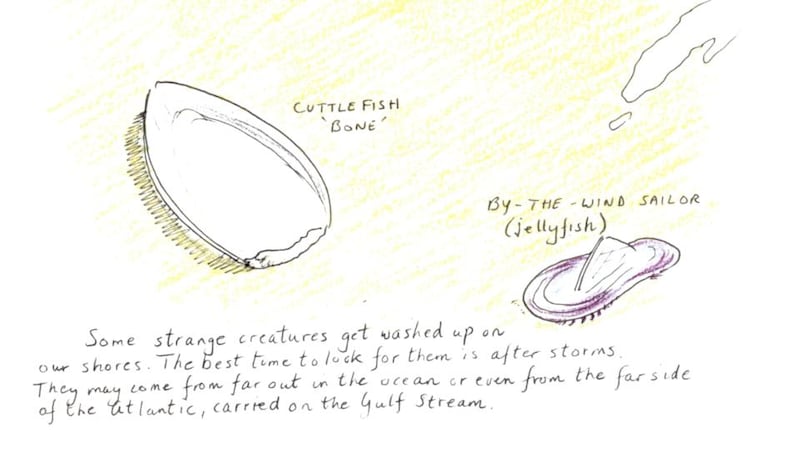‘The one that really fascinated me was the turnstone. It was really cool the way it actually turns stones over, looking for sandhoppers and – what are they called? – larvae.”
Ailsa Clarke, who is 10 and attends Scoil Íde in Salthill, Galway, is talking the day after a class trip to the nearby seashore. It was led by Gordon D'Arcy, the bird artist, author and matchmaker between schoolchildren and the natural world.
“The day was brilliant,” says her classmate, Isobel Ryan. “We got a walk, fresh air, and learned all about birds. Then he taught us to draw them when we got back. I drew a starling, a seagull, seaweed, grass and weeds, all in the one picture.”

Aisling Walsh, who is also 10, agrees. She says two note-takers in the class recorded 26 types of flora (“that’s things like holly and bushes”) and 27 species of fauna (“that’s living things, like oystercatchers”) on their walk.
Like Ailsa, she was intrigued by the turnstone, a small wading bird that’s often very approachable but also well camouflaged. Once you’ve seen one, you’ll start to notice them almost every time you walk a stony shore in winter. Back in school, Aisling learned to draw waves coming up on the beach, and a grey crow dropping a mussel on the stones to crack its shell.
Has the day out with D’Arcy made a difference to her? “Yes,” she says. “When I walk along the seafront from now on I’ll look out for things more.”
It was the first time their teacher, Amanda Bowe, had worked with D’Arcy, though he is a regular visitor to the school. “I’m from Salthill, I’ve walked the strand a million times, and today I’ve seen the same landscape completely differently. Gordon’s expert eye brings science to life. He shows how ecology and biodiversity actually work. And then it’s great the way he brings it all back into the classroom, by helping them draw what they’ve seen, but using their own creativity as well.”
D'Arcy is probably best known for scholarly but accessible books such as Ireland's Lost Birds, a study of our extinct species, enhanced by his evocative scraperboard illustrations, and for books related to the Burren, where he now lives. But his book Narture, published by the Heritage Council for the Heritage in Schools scheme, is different. It is a practical manual for engaging children with nature through art.
Celebrating nature
D’Arcy challenges the “negative context” in which children often learn about nature – climate change, rainforest destruction “and a plethora of other disastrous scenarios”. “Nature should surely be celebrated,” he writes. “We need to create the circumstances whereby children can rediscover its subtle but ever-revealing magic.”
D’Arcy’s books have always shown awareness of the intense relationships between culture and nature, in folklore and in poetry, and he uses these elements, and the Irish language, in building contexts for children to discover landscapes, plants and animals.
On one page of Narture you will find comical sketches of common myths: a hedgehog sucking on a cow's udder, a bat in a girl's hair, an earwig slipping into an ear. On the next is serious text about Ireland's Ice Age survivors the hare and the stoat, plus simple guidance for drawing them: overlapping circles for the hare, an upright rectangle for a standing stoat. (As well as, elsewhere, tips for drawing a mammoth, and a guide to some unusual shore finds.) The marvellous work of Éamon de Buitléar and Gerrit Van Gelderen, who also married art and nature in their TV series Amuigh Faoin Spéir, springs to mind.
There is plenty of material for secondary students, too. There are imaginative instructions for building a “bog in a box”, and issues such as climate change do get space – they are just not the dominant message.
D'Arcy is an admirer of Richard Louv, the American author of Last Child in the Woods: Saving Our Children from Nature-Deficit Disorder. This is the book that sparked the influential No Child Left Inside movement. Like Louw, D'Arcy believes the latest generation has become disconnected from nature to an unprecedented degree.
“I walked to school every day as a child,” he says. “I was interested in everything I saw, from the dead frog on the road to the changing seasons.”
So he starts his nature walks by encouraging the children “to get their senses working properly. Don’t chat to your friend as you walk today but listen, look, touch, maybe even taste what is around you.”
Neither the ramble nor the art session feels like a conventional class. Children learn new things precisely because they don’t feel they are learning in the way they normally do. They pay attention because their imagination has been captured, not because they have been told to. For the art sessions he makes a point of mostly working on images of animals or plants they have seen, or at least found traces of, and not working from photographs.
But the back cover of Narture shows him with a sketch of an otter. Had he really managed to stalk this shyest of our mammals with a large group of children? "Maybe I was cheating a bit there," he says wryly. "But there were otters where we were walking, and we did find their spraints, bits of fish they had been eating, and the chutes they use to access the river."
One way or another, the children clearly learned a lot that day.
gordondarcynature.com


















